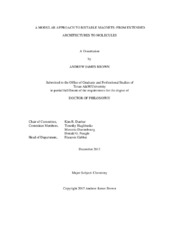| dc.description.abstract | This dissertation describes structural and magnetic studies of three-dimensional Prussian Blue analogs (PBAs), one-dimensional single chain compounds, and discrete “zero-dimensional” molecules. All compounds that were studied are members of a large class of materials known as molecular nanomagnets which exhibit a barrier to spin reversal due to magnetic anisotropy which can surpass the superparamagnetic limit of classical materials. Single-molecule magnets (SMMs) which can exhibit long-lived relaxation times for their magnetic states are the prototype for the field and are poised for implementation in next generation nanoelectronic devices. The goal of this dissertation research was to determine sources of anisotropy in the quest for interesting magnetic properties.
Prussian Blue, FeIII4[FeII(CN)6]3·16H2O, exhibits ferromagnetic coupling with a Curie temperature of approximately 5 K. Different synthetic attempts historically yield slightly different formulations of the compound. We have revisited the structural analysis of this compound and have obtained the first crystal structure of Turnbull’s Blue, KFeIII[FeII(CN)6].
Capping ligands can reduce the dimension of PBAs while retaining their interesting properties. This strategy is presented by the reactions of tptz (tptz = 2,4,6-tris(2-pyridyl)-1,3,5-triazine) complexes of Cu(II), Co(II), and Fe(III) with [MV(CN)8]3- (M = Mo, W) anions which led to three new heterobimetallic chains based on ladder- or square structural motifs. The compound {[FeIII(tptz)WV(CN)8]·2CH3OH}∞ exhibits weak out-of-phase AC signals at low temperature, which indicates single-chain magnet behavior.
The blocking of all open coordination sites results in discrete molecules with the potential for SMM behavior. Underexplored transition and lanthanide metals with specific ligand fields afford single-ion anisotropies providing an easy-axis for the magnetization. In this regard, the new trigonally capped titanium (III) precursor, [Et4N][Tp*Ti(CN)3] (Tp* = tris(3,5-dimethylpyrazolyl)borohydride), was prepared. Concomitant hydrolysis, oxidation, and coordination of this titanium precursor affords a family of trinuclear carboxylate compounds, {(Tp*TiIV)(μ2-OAc)2(μ2-O)M(μ2-O)(μ2-OAc)2(TiIVTp*)} (M = CrIII, MnII, CoII), with interesting magnetic properties.
The use of the equatorially coordinating bis(trimethylsilyl)amide ligand, [N(SiMe3)2]-, enforces a trigonal pyramidal framework for the stabilization of prolate lanthanide SMMs. The compounds, [Li(THF)4]{LnIII[N(SiMe3)2]3Cl} (Ln = Er, Tm), exhibit single-molecule magnet behavior with the erbium analog showing magnetic hysteresis up to 3 K. | en |


